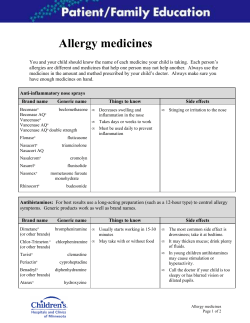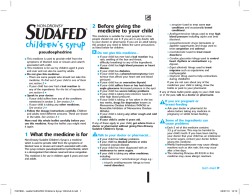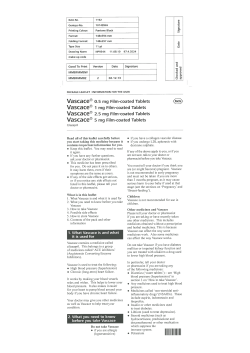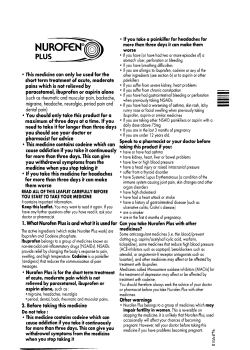
Medication Safety for Children: A Guide for Parents and Caregivers
Medication Safety for Children: A Guide for Parents and Caregivers When it comes to medicine, children are not just “little adults.” If you take care of a child, know these special safety considerations for both prescription and nonprescription medications. Prescription medicines: Get the facts Never give a child a prescription medication intended for an adult or another child. If a medicine is prescribed for your child by a physician or another member of the family’s health care team, two important ways to reduce the risk of any safety problems with the medicine are: • Tell the prescriber about your child’s health and other medications taken. • Ask about the medication being prescribed. Tell the doctor: • Your child’s medical history. • Any allergies or sensitivities he or she has experienced. • Any concerns that would affect your child’s ability to take medicine, such as difficulty swallowing tablets. • Any other prescription or nonprescription medications, vitamins or supplements, herbal or other natural or alternative remedies your child is taking. Ask the doctor: • What is the medicine and what is it for? • Could this medicine interact with any other prescription or nonprescription medications my child is taking? • How often should my child take this medicine? For how many days or weeks? • What if I miss giving my child a dose? • How soon will the medicine start to work? • What side effects might occur? • What should I do if my child seems to develop any of these side effects? • Should I stop giving the medicine when my child gets better? • Can the medicine affect my child’s performance at school? • Can the medicine have any long-term effects on my child’s growth and development? At the pharmacy: • Check that the medicine looks like what you expected from the doctor's description, and that the label matches what the doctor prescribed. If not, ask the pharmacist about it. • Read any printed information that comes with the medicine. If you have any questions, ask the pharmacist or your doctor. © 2011 Pfizer Inc. All rights reserved. Version 2.0. October 2011. For more information on medicine safety, please visit: www.pfizer.com/medicinesafety 1 Medication Safety for Children: A Guide for Parents and Caregivers Keeping track of dosage Children’s small bodies are vulnerable to the risk of If your child will need to have a accidental overdose. That’s why accurate dosing medicine administered in school and measurement of children’s medications, or day care… especially liquids, is so important. When your child Learn how the procedure is takes any medication, start a simple record (like a handled there, and make sure the chart or checklist) of each dose given and when. safeguards listed on this sheet are Don't rely on young children to tell you whether they in place. have taken their medicine—they may say “yes” because they don’t like it, or even “no” to get a second dose if they liked the flavoring. Watch them take the entire dose. Measurements count! Age is not always an accurate measure of how much medicine to give your child. Check the “Drug Facts” label of nonprescription medicines and, if the information is available, use your child’s weight to find the right dose. Don’t guess. If you are not sure or do not understand the label instructions, ask your doctor or pharmacist. Use the measuring tool that comes with your child’s medicine. If a product doesn’t come with a special measuring tool, ask for one at the pharmacy; a household spoon may not hold a precisely accurate amount of medicine. The numbers on measuring devices are small, so read them carefully. Here are some tips for accurate measuring: Dosage cups are for children who can drink from a cup without spilling. Look closely at the numbers on the side; measure out the liquid with the cup at eye level on a flat surface. Cylindrical dosing spoons are for children who can drink from a cup but are still prone to spill. These devices look like a wide straw with a little spoon at the top. Measure the liquid in the spoon at eye level, and have the child sip the medicine from the spoon. Droppers are for children who can't drink from a cup. Put the medicine into the dropper and measure at eye level; give to the child quickly before the medicine drips out. Syringes are another option for children who can't drink from a cup, allowing you to squirt the medicine into the back of the child's mouth. If a syringe comes with a cap to keep medicine from leaking out, remove and discard the cap (a choking hazard) before giving the medicine. For some medicines, a syringe may be filled with the right dose and left, capped, for a caregiver to give to your child later. (Tell the caregiver to remove the cap first and discard it.) Use only clean syringes specially made for giving medicines to children. Be sure to store the filled syringe at the right temperature and never leave it where children or pets may get it. © 2011 Pfizer Inc. All rights reserved. Version 2.0. October 2011. For more information on medicine safety, please visit: www.pfizer.com/medicinesafety 2 Medication Safety for Children: A Guide for Parents and Caregivers Special cautions for nonprescription medicines Medicines purchased without a prescription (called “over-the-counter,” or nonprescription, medicines) often contain the same ingredients as prescription medicines and can pose serious safety risks. Give infants and children only medications specifically formulated for their age and weight. Don’t cut adult tablets in half or estimate a child’s dose of an adult-strength liquid product. If you have any questions about a nonprescription medicine for your child, ask your pharmacist or doctor for advice. Give nonprescription medicine to a child Children and aspirin: A warning using the same safety steps as for prescription medicine: read the label, Avoid giving a child aspirin or other measure accurate doses, and ask your medicines that belong to a group of drugs called salicylates, alone or in combination doctor or pharmacist for advice. The U.S. with other medicines. These drugs may Food and Drug Administration offers these 10 raise the risk of a rare but serious condition safety rules for children’s nonprescription called Reye’s syndrome. For many children, medicines: fever and aches and pains may be treated 1. Read and follow label directions every instead with ibuprofen or acetaminophen, time. Pay special attention to usage but be sure to ask your child’s doctor what directions and warnings. If you notice is most appropriate for him or her. any new symptoms or unexpected side effects in your child or the medicine doesn’t appear to be working, talk to your doctor or pharmacist immediately. 2. Know how much medicine to give and when. Read and follow the label. 3. Know the abbreviations for tablespoon (tbsp.) and teaspoon (tsp.). You should also know milligram (mg.), milliliter (mL.), and ounce (oz.). 4. Use the correct dosing device. If the label says two teaspoons and you’re using a dosing cup with ounces only, don't guess—get the proper measuring device. Don’t substitute another item, such as a kitchen spoon. 5. Never play doctor. Twice the recommended dose is not appropriate just because your child seems twice as sick as last time. When in doubt about your child's condition, call your doctor. 6. Talk to your doctor, pharmacist, or other health care professional before giving two medicines at the same time to avoid a possible overdose or an unwanted interaction. 7. Follow age and weight limit recommendations. If the label says don’t give to children under a certain age or weight, don’t do it. Call your doctor. 8. Always use the child-resistant cap and relock the cap after each use. Be especially careful with iron-containing vitamins or supplements, which have been a source of accidental poisoning deaths in children under three. 9. Follow the “KEEP OUT OF REACH” warning. Today’s medicines are often flavored to mask the taste of the medicine, which is all the more reason to keep all medicines out of the sight and reach of children. © 2011 Pfizer Inc. All rights reserved. Version 2.0. October 2011. For more information on medicine safety, please visit: www.pfizer.com/medicinesafety 3 Medication Safety for Children: A Guide for Parents and Caregivers 10. Always check the package and medicine itself for signs of tampering. Don't buy or use any medicine from a package that shows cuts, tears, slices, or other imperfections. Report anything suspicious to the pharmacist or store manager. In addition, don’t use medicines that are past their expiration dates. If a medicine has no expiration date, use it for no more than a year after purchase. Take nonprescription medications for their intended use (for example, don’t use a sedating cold medicine as a sleep aid). Finally, keep in mind that most nonprescription medicines are intended for temporary relief of minor symptoms. If your child’s condition does not go away or gets worse, contact your pediatrician or other health care professional. Prevent accidental poisoning Vaccines and safety Many pediatric vaccines are important tools in preventing and eradicating lifethreatening diseases. Immunizations, like any medication, can cause side effects. However, a decision not to immunize a child can also involve risk—not only to the child, but also to those who come into contact with him or her. For this reason, some immunizations are required in order for children to attend school or other activities. Ask your pediatrician about following federal childhood immunization schedules. For more information, contact the Immunization Call Center at 800-232-4636 (800CDC-INFO), or e-mail questions to mailto:nipinfo@cdc.gov. More than half of all accidental poisonings occur in children younger than age six, and medicines are among the risks found in every household. • Avoid taking medications in front of your children, who often try to imitate adults. • Never call medicine "candy." • Check that medications are supplied in childproof containers. • Keep all medications (both prescription and nonprescription) in their original, childresistant containers. • Always turn on the light when giving or taking medicine. • Check medications for expiration dates. If a product is not dated, discard it a year or less after purchase. • Avoid discarding medications in open trash containers in the kitchen or bathroom where children or pets could get to them. For more information on safe disposal of medicines, refer to the information sheet “Avoiding Medication Errors.” • In cases of poisoning in the United States, call your local poison control center or 800-222-1222, the national phone number for poison control centers, or 911. Outside of the United States, check your local listing for poison control centers. © 2011 Pfizer Inc. All rights reserved. Version 2.0. October 2011. For more information on medicine safety, please visit: www.pfizer.com/medicinesafety 4
© Copyright 2025





















